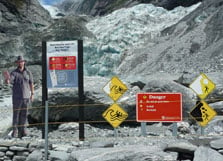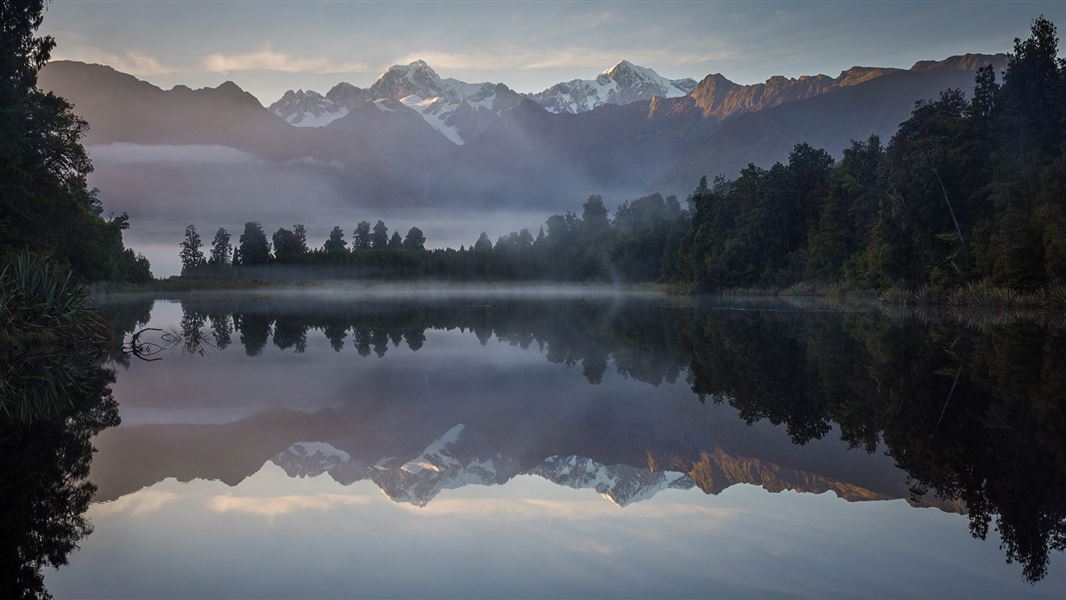This world-class scenic landscape forms part of Te Wāhipounamu South West New Zealand World Heritage Area and is a treasure trove of amazing geology, rare flora and fauna and wonderful history.
Dog access
No dogs. Other pets on conservation land rules.
Nature's in trouble
Thousands of New Zealand’s native species are heading towards extinction. Once they’re gone, they’re gone for good. Nature needs your help.
Franz Josef Glacier/Kā Roimata o Hine Hukatere and Fox Glacier area provide an opportunity to experience a dynamic glacial environment within driving and walking distance from the main highway.
Waiho River bed, in the general area between the Callery Gorge suspension bridge and the Waiho River road bridge, has a recreational gold fossicking area - a permit is not required. See Gold fossicking on the New Zealand Petroleum & Minerals website for more information.
Westland Tai Poutini National Park Visitor Centre provides information about recreation throughout the glacier region, and to learn about the natural features and history of the area.
Westland Tai Poutini National Park is located about halfway down the rugged West Coast of the South Island. The only road access is on SH6, via Hokitika in the north (approximately one and a half hours drive) or from the south via Haast (approximately two hours drive).
The townships of Franz Josef/Waiau and Fox Glacier/Weheka are on the park boundary and offer various services including accommodation, service stations, grocery stores and souvenir shops. Ōkārito is also on the edge of the park and has several accommodation options.
The closest commercial airport is in Hokitika, which has daily flights from Christchurch. There are also regular bus services along the coast.
Check weather and track conditions
Westland Tai Poutini National Park lies in the path of the prevailing westerly winds, which can bring heavy rain at any time of the year, with up to five metres falling annually.
Weather conditions can change dramatically, in a short space of time, so make sure you check the latest forecast at the Westland Tai Poutini National Park Visitor Centre in Franz Josef/Waiau.
While you are there, make sure you check the current track conditions to ensure you have the most up-to-date information before heading out to explore the park.
Westland Tai Poutini National Park weather forecast – NIWA website

Safety signs, Franz Josef Glacier
Equipment
Come prepared to encounter all conditions – you should carry warm and waterproof clothing with you at all times. And don’t forget to bring insect repellent as sandflies are prevalent.
If you use the track system in the park for overnight trips, make sure you are properly equipped and well prepared. Make sure your group has a capable leader and that everyone is carrying a sleeping bag, cooking utensils, sufficient high energy food (with some extra for emergencies), a waterproof raincoat and overtrousers, gloves, a hat, and several layers of warm (wool or fleece) clothing.
Visiting the glaciers
Viewing the glaciers is an exciting experience, but it can also be dangerous.
Visit the Glacier Country website to view the latest daily glacier access update.
Gold fossicking
A recreational gold fossicking area is located on the Waiho River bed in the general area between the Callery Gorge suspension bridge and the Waiho River road bridge. You are welcome to try your luck at finding gold with a gold pan or sluice box. No licence is required but your respect is appreciated.
Accessing the gold fossicking area
- off SH6 at the Waiho River bridge, approximately 200 metres south of the Franz Josef/Waiau village. Access is up the true right of the Waiho River, and dependent on river conditions you may be able to get as far as the Callery Bridge from this access point.
- using the Franz Josef Glacier road which provides access to the section of the gold fossicking area on the true left of the Waiho River.
Do not attempt to cross the Callery or Waiho Rivers on foot as both are very swift, cold and dangerous. Use the Waiho Road bridge.
A map of the area can be obtained from the New Zealand Petroleum and Mineral website. Check the map carefully as the gold fossicking area is not marked.
Check the visitor centre for more details.
You can only fossick for gold in designated areas. Only hand-held tools are allowed. More on gold fossicking areas and rules.
All drone use must be authorised by DOC
You must have a permit to fly a drone on public conservation land.
Visit our Drone use on conservation land page for more information.
Westland Tai Poutini National Park was established in 1960. Split by the Alpine Fault, it is a place of dramatic contrasts.
To the east of the fault mountains rise suddenly, and steep forested slopes are cut deeply with impassable gorges.
High above, permanent snowfields feed a myriad of glaciers, including Fox Glacier/Te Moeka o Tuawe and Franz Josef Glacier/Kā Roimata o Hine Hukatere, which descend right down to the lowlands.
Dense rainforest covers the lowlands west of the fault. Nearer the coast, there are scenic lakes, wetlands and wide river mouths.
Wading birds and other water-loving creatures thrive in the wetlands around the coast. The threatened kāmana/crested grebe, can be found on Lake Māpōurika, and Ōkārito Lagoon is famous for the stunning kōtuku/white heron.
In the heart of lowland forest lives the only population of the endangered rowi – New Zealand’s rarest kiwi. Kea are common throughout the park, and the forest is alive with birdlife.
Plentiful food led to early Maori settlements, gold and glaciers bought the Europeans in the late 1800s and early 1900s. Learn about the early exploration and formation of Westland Tai Poutini National Park.
Check, Clean, Dry
Clean all gear when moving between waterways to prevent the spread of didymo and other freshwater pests.
Westland Tai Poutini National Park Visitor Centre
| Phone: | +64 3 752 0360 |
| Email: | westlandnpvc@doc.govt.nz |
| Address: | 69 Cron Street Franz Josef Glacier 7856 |
| Hours: | Visitor centre hours and services |

